Enterprise Resource Planning (ERP) in Higher Education: A Portfolio
VerifiedAdded on 2022/11/22
|14
|3956
|411
Report
AI Summary
This report is a comprehensive portfolio summarizing nine distinct articles that explore the effects and implications of Enterprise Resource Planning (ERP) systems in higher education. The report delves into the historical context of ERP, originally designed for business process improvement, and its relatively recent adoption in higher education. It examines key aspects such as the implications of ERP, the current state and future directions of ERP in education, and the challenges and opportunities associated with its implementation. The analysis covers various perspectives, including literature reviews, maturity models, technological transformations, and case studies from institutions like Egyptian HEIs, addressing topics from technical issues and user perspectives to the automation of learning and student needs, and leadership considerations. The report also highlights critical success factors, the importance of system training, and the potential for ERP to improve efficiency, service quality, and data security within educational settings, providing a multifaceted view of ERP's role in the higher education landscape.
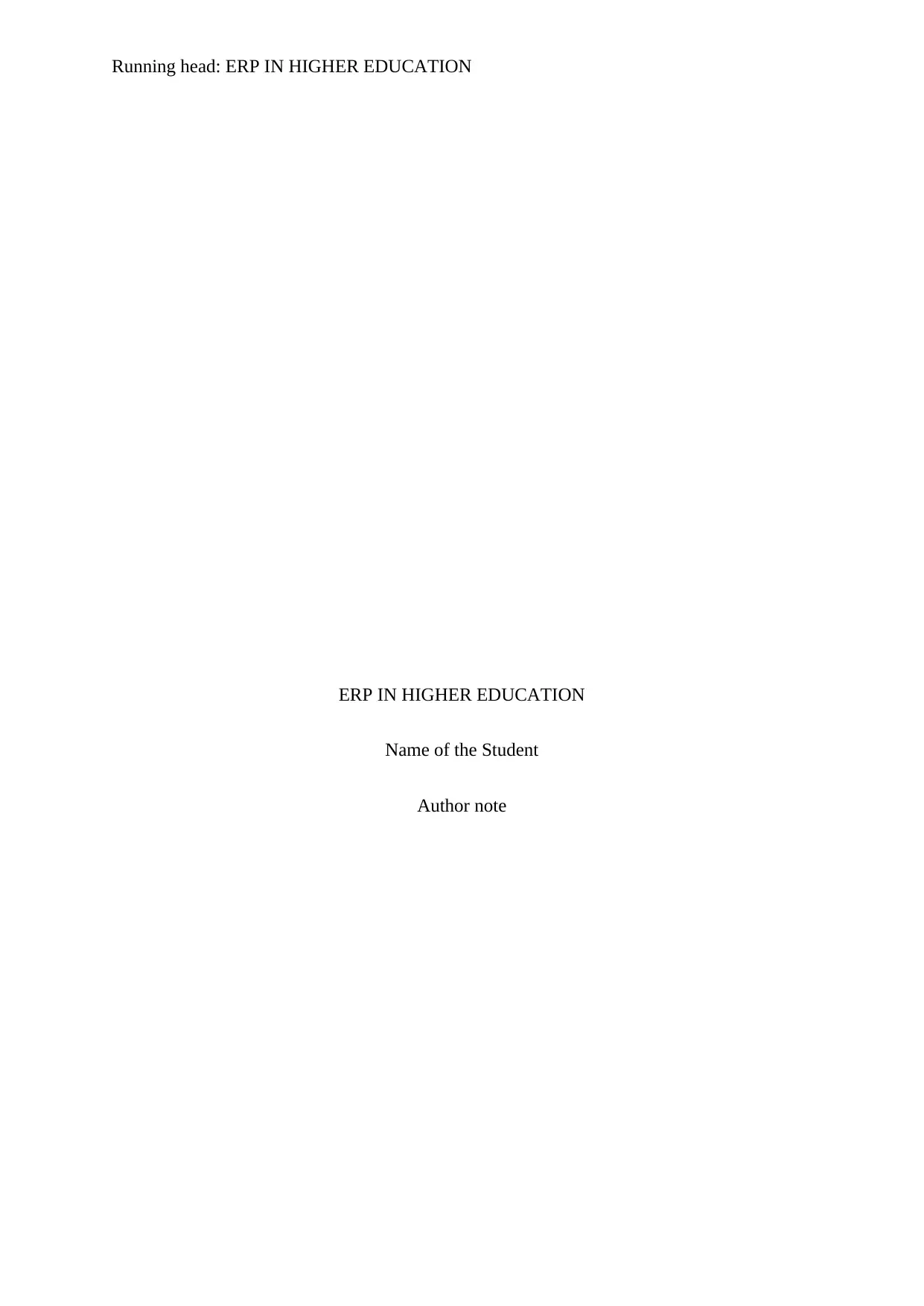
Running head: ERP IN HIGHER EDUCATION
ERP IN HIGHER EDUCATION
Name of the Student
Author note
ERP IN HIGHER EDUCATION
Name of the Student
Author note
Paraphrase This Document
Need a fresh take? Get an instant paraphrase of this document with our AI Paraphraser
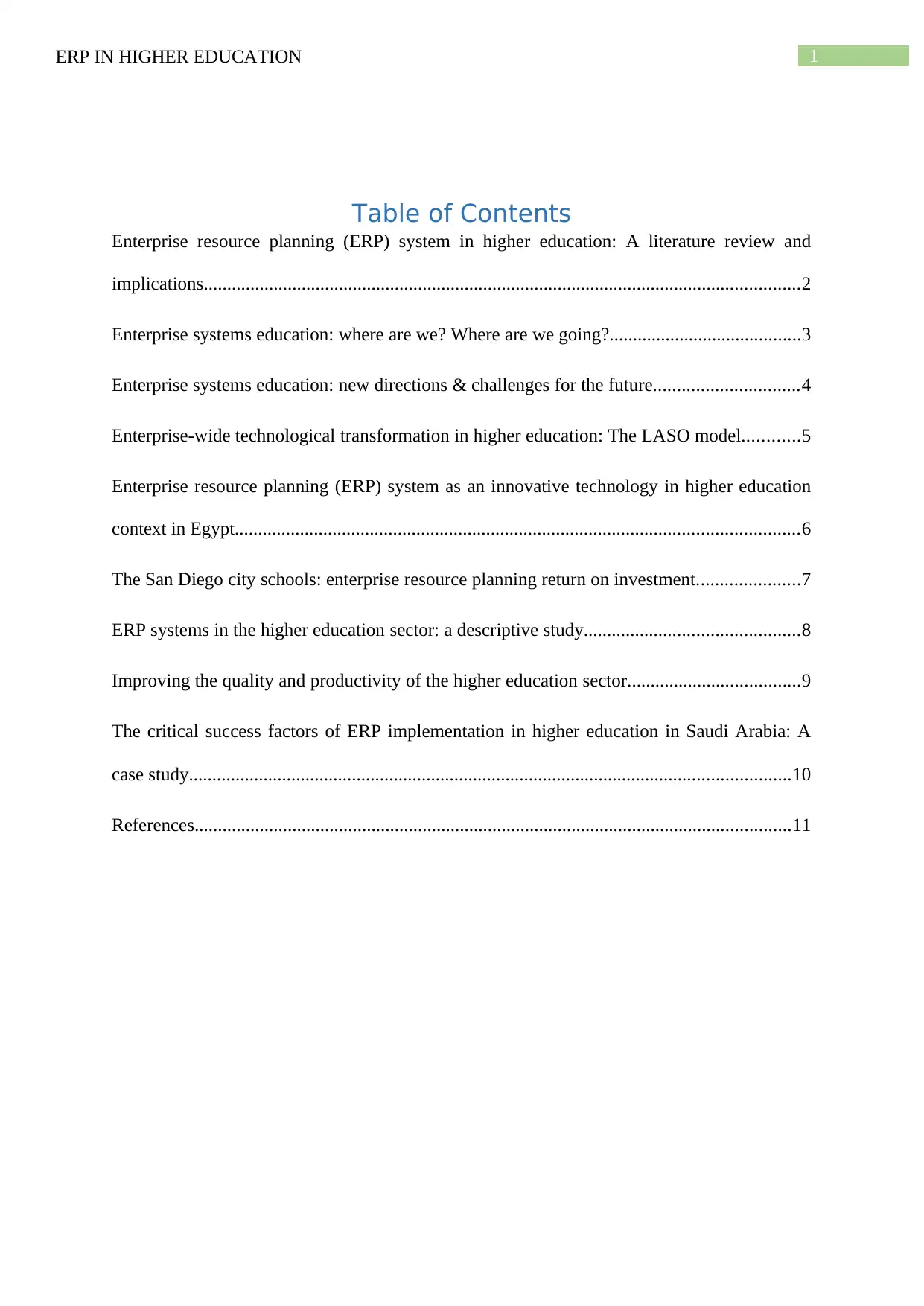
1ERP IN HIGHER EDUCATION
Table of Contents
Enterprise resource planning (ERP) system in higher education: A literature review and
implications................................................................................................................................2
Enterprise systems education: where are we? Where are we going?.........................................3
Enterprise systems education: new directions & challenges for the future...............................4
Enterprise-wide technological transformation in higher education: The LASO model............5
Enterprise resource planning (ERP) system as an innovative technology in higher education
context in Egypt.........................................................................................................................6
The San Diego city schools: enterprise resource planning return on investment......................7
ERP systems in the higher education sector: a descriptive study..............................................8
Improving the quality and productivity of the higher education sector.....................................9
The critical success factors of ERP implementation in higher education in Saudi Arabia: A
case study.................................................................................................................................10
References................................................................................................................................11
Table of Contents
Enterprise resource planning (ERP) system in higher education: A literature review and
implications................................................................................................................................2
Enterprise systems education: where are we? Where are we going?.........................................3
Enterprise systems education: new directions & challenges for the future...............................4
Enterprise-wide technological transformation in higher education: The LASO model............5
Enterprise resource planning (ERP) system as an innovative technology in higher education
context in Egypt.........................................................................................................................6
The San Diego city schools: enterprise resource planning return on investment......................7
ERP systems in the higher education sector: a descriptive study..............................................8
Improving the quality and productivity of the higher education sector.....................................9
The critical success factors of ERP implementation in higher education in Saudi Arabia: A
case study.................................................................................................................................10
References................................................................................................................................11
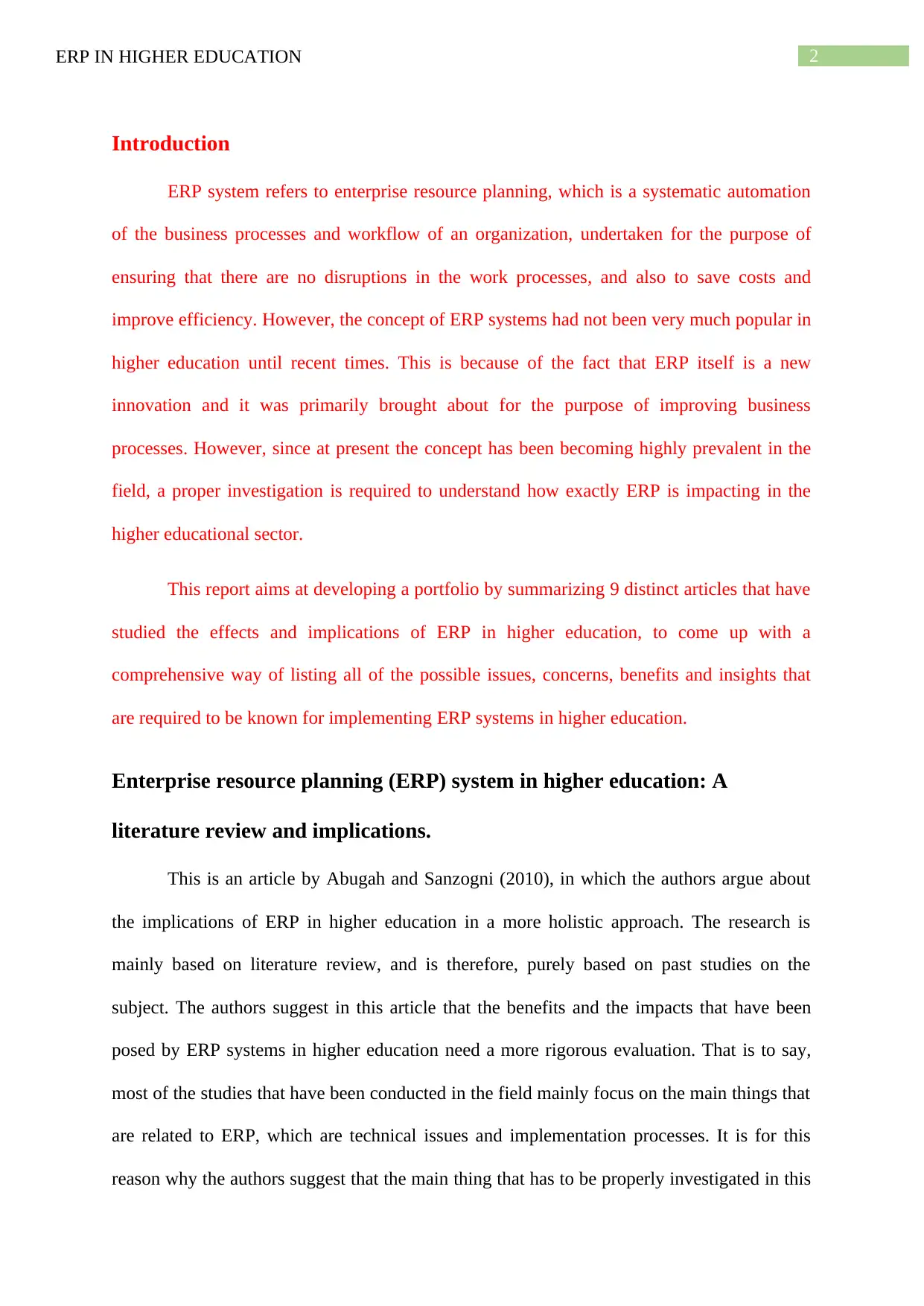
2ERP IN HIGHER EDUCATION
Introduction
ERP system refers to enterprise resource planning, which is a systematic automation
of the business processes and workflow of an organization, undertaken for the purpose of
ensuring that there are no disruptions in the work processes, and also to save costs and
improve efficiency. However, the concept of ERP systems had not been very much popular in
higher education until recent times. This is because of the fact that ERP itself is a new
innovation and it was primarily brought about for the purpose of improving business
processes. However, since at present the concept has been becoming highly prevalent in the
field, a proper investigation is required to understand how exactly ERP is impacting in the
higher educational sector.
This report aims at developing a portfolio by summarizing 9 distinct articles that have
studied the effects and implications of ERP in higher education, to come up with a
comprehensive way of listing all of the possible issues, concerns, benefits and insights that
are required to be known for implementing ERP systems in higher education.
Enterprise resource planning (ERP) system in higher education: A
literature review and implications.
This is an article by Abugah and Sanzogni (2010), in which the authors argue about
the implications of ERP in higher education in a more holistic approach. The research is
mainly based on literature review, and is therefore, purely based on past studies on the
subject. The authors suggest in this article that the benefits and the impacts that have been
posed by ERP systems in higher education need a more rigorous evaluation. That is to say,
most of the studies that have been conducted in the field mainly focus on the main things that
are related to ERP, which are technical issues and implementation processes. It is for this
reason why the authors suggest that the main thing that has to be properly investigated in this
Introduction
ERP system refers to enterprise resource planning, which is a systematic automation
of the business processes and workflow of an organization, undertaken for the purpose of
ensuring that there are no disruptions in the work processes, and also to save costs and
improve efficiency. However, the concept of ERP systems had not been very much popular in
higher education until recent times. This is because of the fact that ERP itself is a new
innovation and it was primarily brought about for the purpose of improving business
processes. However, since at present the concept has been becoming highly prevalent in the
field, a proper investigation is required to understand how exactly ERP is impacting in the
higher educational sector.
This report aims at developing a portfolio by summarizing 9 distinct articles that have
studied the effects and implications of ERP in higher education, to come up with a
comprehensive way of listing all of the possible issues, concerns, benefits and insights that
are required to be known for implementing ERP systems in higher education.
Enterprise resource planning (ERP) system in higher education: A
literature review and implications.
This is an article by Abugah and Sanzogni (2010), in which the authors argue about
the implications of ERP in higher education in a more holistic approach. The research is
mainly based on literature review, and is therefore, purely based on past studies on the
subject. The authors suggest in this article that the benefits and the impacts that have been
posed by ERP systems in higher education need a more rigorous evaluation. That is to say,
most of the studies that have been conducted in the field mainly focus on the main things that
are related to ERP, which are technical issues and implementation processes. It is for this
reason why the authors suggest that the main thing that has to be properly investigated in this
⊘ This is a preview!⊘
Do you want full access?
Subscribe today to unlock all pages.

Trusted by 1+ million students worldwide
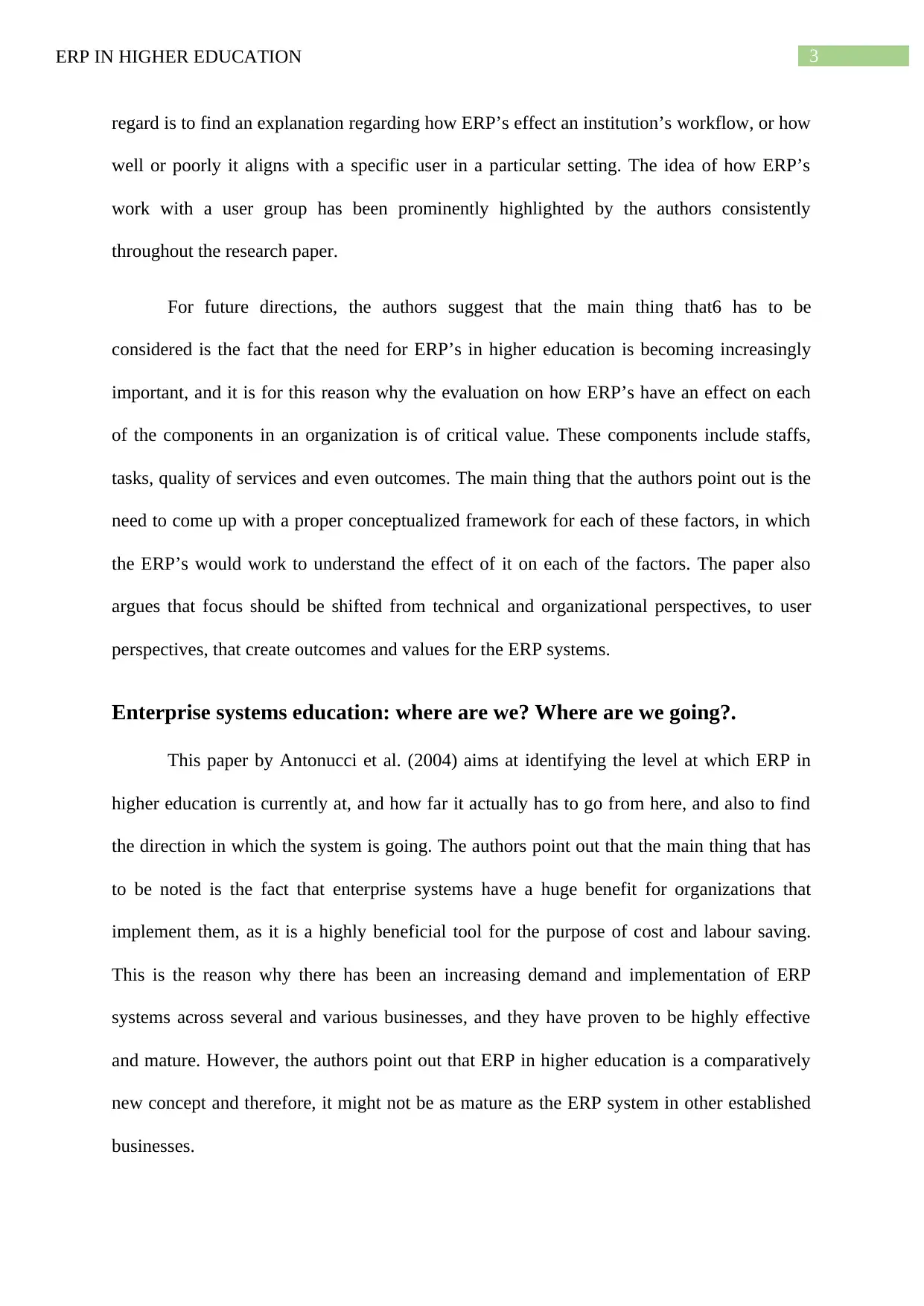
3ERP IN HIGHER EDUCATION
regard is to find an explanation regarding how ERP’s effect an institution’s workflow, or how
well or poorly it aligns with a specific user in a particular setting. The idea of how ERP’s
work with a user group has been prominently highlighted by the authors consistently
throughout the research paper.
For future directions, the authors suggest that the main thing that6 has to be
considered is the fact that the need for ERP’s in higher education is becoming increasingly
important, and it is for this reason why the evaluation on how ERP’s have an effect on each
of the components in an organization is of critical value. These components include staffs,
tasks, quality of services and even outcomes. The main thing that the authors point out is the
need to come up with a proper conceptualized framework for each of these factors, in which
the ERP’s would work to understand the effect of it on each of the factors. The paper also
argues that focus should be shifted from technical and organizational perspectives, to user
perspectives, that create outcomes and values for the ERP systems.
Enterprise systems education: where are we? Where are we going?.
This paper by Antonucci et al. (2004) aims at identifying the level at which ERP in
higher education is currently at, and how far it actually has to go from here, and also to find
the direction in which the system is going. The authors point out that the main thing that has
to be noted is the fact that enterprise systems have a huge benefit for organizations that
implement them, as it is a highly beneficial tool for the purpose of cost and labour saving.
This is the reason why there has been an increasing demand and implementation of ERP
systems across several and various businesses, and they have proven to be highly effective
and mature. However, the authors point out that ERP in higher education is a comparatively
new concept and therefore, it might not be as mature as the ERP system in other established
businesses.
regard is to find an explanation regarding how ERP’s effect an institution’s workflow, or how
well or poorly it aligns with a specific user in a particular setting. The idea of how ERP’s
work with a user group has been prominently highlighted by the authors consistently
throughout the research paper.
For future directions, the authors suggest that the main thing that6 has to be
considered is the fact that the need for ERP’s in higher education is becoming increasingly
important, and it is for this reason why the evaluation on how ERP’s have an effect on each
of the components in an organization is of critical value. These components include staffs,
tasks, quality of services and even outcomes. The main thing that the authors point out is the
need to come up with a proper conceptualized framework for each of these factors, in which
the ERP’s would work to understand the effect of it on each of the factors. The paper also
argues that focus should be shifted from technical and organizational perspectives, to user
perspectives, that create outcomes and values for the ERP systems.
Enterprise systems education: where are we? Where are we going?.
This paper by Antonucci et al. (2004) aims at identifying the level at which ERP in
higher education is currently at, and how far it actually has to go from here, and also to find
the direction in which the system is going. The authors point out that the main thing that has
to be noted is the fact that enterprise systems have a huge benefit for organizations that
implement them, as it is a highly beneficial tool for the purpose of cost and labour saving.
This is the reason why there has been an increasing demand and implementation of ERP
systems across several and various businesses, and they have proven to be highly effective
and mature. However, the authors point out that ERP in higher education is a comparatively
new concept and therefore, it might not be as mature as the ERP system in other established
businesses.
Paraphrase This Document
Need a fresh take? Get an instant paraphrase of this document with our AI Paraphraser
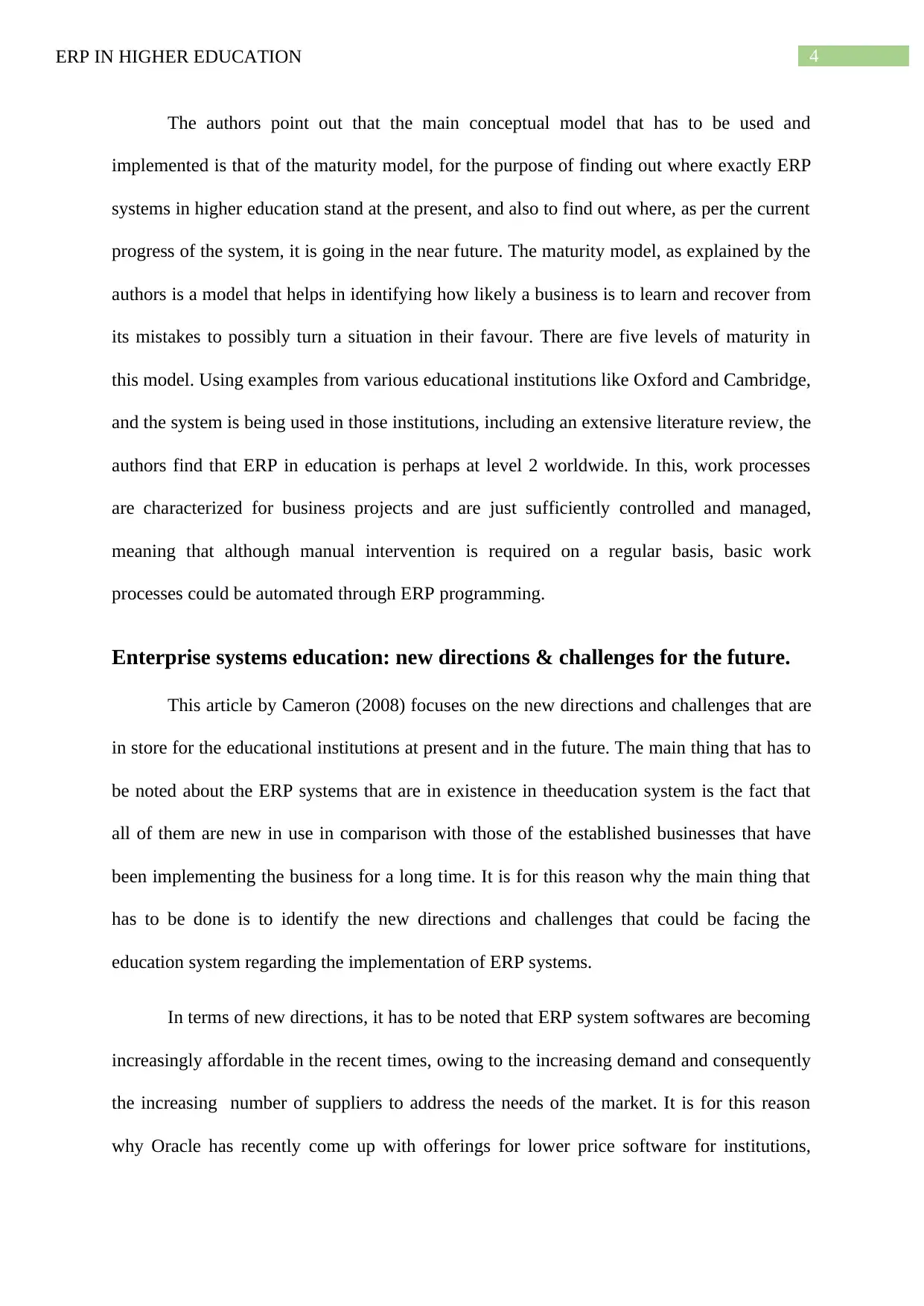
4ERP IN HIGHER EDUCATION
The authors point out that the main conceptual model that has to be used and
implemented is that of the maturity model, for the purpose of finding out where exactly ERP
systems in higher education stand at the present, and also to find out where, as per the current
progress of the system, it is going in the near future. The maturity model, as explained by the
authors is a model that helps in identifying how likely a business is to learn and recover from
its mistakes to possibly turn a situation in their favour. There are five levels of maturity in
this model. Using examples from various educational institutions like Oxford and Cambridge,
and the system is being used in those institutions, including an extensive literature review, the
authors find that ERP in education is perhaps at level 2 worldwide. In this, work processes
are characterized for business projects and are just sufficiently controlled and managed,
meaning that although manual intervention is required on a regular basis, basic work
processes could be automated through ERP programming.
Enterprise systems education: new directions & challenges for the future.
This article by Cameron (2008) focuses on the new directions and challenges that are
in store for the educational institutions at present and in the future. The main thing that has to
be noted about the ERP systems that are in existence in theeducation system is the fact that
all of them are new in use in comparison with those of the established businesses that have
been implementing the business for a long time. It is for this reason why the main thing that
has to be done is to identify the new directions and challenges that could be facing the
education system regarding the implementation of ERP systems.
In terms of new directions, it has to be noted that ERP system softwares are becoming
increasingly affordable in the recent times, owing to the increasing demand and consequently
the increasing number of suppliers to address the needs of the market. It is for this reason
why Oracle has recently come up with offerings for lower price software for institutions,
The authors point out that the main conceptual model that has to be used and
implemented is that of the maturity model, for the purpose of finding out where exactly ERP
systems in higher education stand at the present, and also to find out where, as per the current
progress of the system, it is going in the near future. The maturity model, as explained by the
authors is a model that helps in identifying how likely a business is to learn and recover from
its mistakes to possibly turn a situation in their favour. There are five levels of maturity in
this model. Using examples from various educational institutions like Oxford and Cambridge,
and the system is being used in those institutions, including an extensive literature review, the
authors find that ERP in education is perhaps at level 2 worldwide. In this, work processes
are characterized for business projects and are just sufficiently controlled and managed,
meaning that although manual intervention is required on a regular basis, basic work
processes could be automated through ERP programming.
Enterprise systems education: new directions & challenges for the future.
This article by Cameron (2008) focuses on the new directions and challenges that are
in store for the educational institutions at present and in the future. The main thing that has to
be noted about the ERP systems that are in existence in theeducation system is the fact that
all of them are new in use in comparison with those of the established businesses that have
been implementing the business for a long time. It is for this reason why the main thing that
has to be done is to identify the new directions and challenges that could be facing the
education system regarding the implementation of ERP systems.
In terms of new directions, it has to be noted that ERP system softwares are becoming
increasingly affordable in the recent times, owing to the increasing demand and consequently
the increasing number of suppliers to address the needs of the market. It is for this reason
why Oracle has recently come up with offerings for lower price software for institutions,
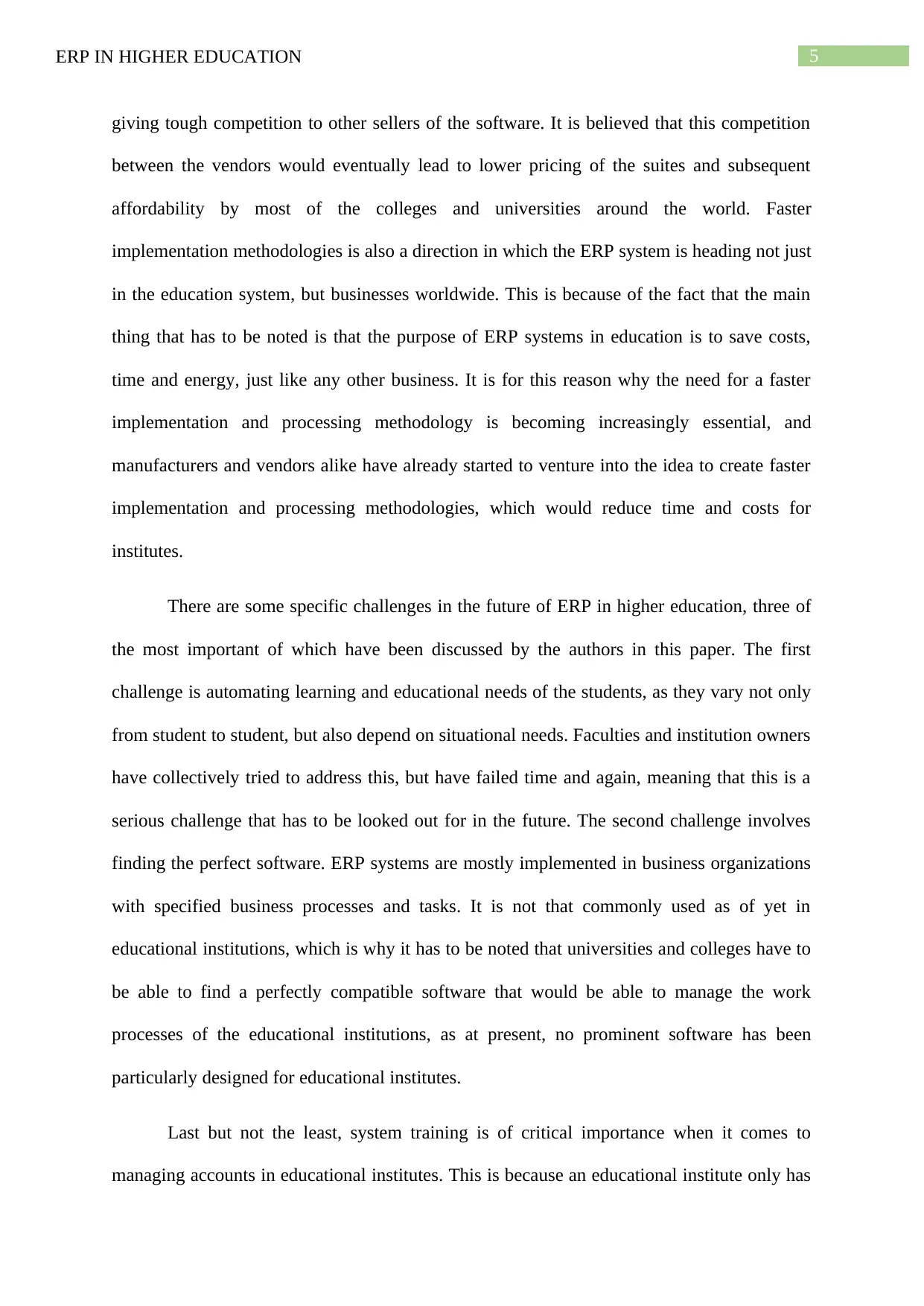
5ERP IN HIGHER EDUCATION
giving tough competition to other sellers of the software. It is believed that this competition
between the vendors would eventually lead to lower pricing of the suites and subsequent
affordability by most of the colleges and universities around the world. Faster
implementation methodologies is also a direction in which the ERP system is heading not just
in the education system, but businesses worldwide. This is because of the fact that the main
thing that has to be noted is that the purpose of ERP systems in education is to save costs,
time and energy, just like any other business. It is for this reason why the need for a faster
implementation and processing methodology is becoming increasingly essential, and
manufacturers and vendors alike have already started to venture into the idea to create faster
implementation and processing methodologies, which would reduce time and costs for
institutes.
There are some specific challenges in the future of ERP in higher education, three of
the most important of which have been discussed by the authors in this paper. The first
challenge is automating learning and educational needs of the students, as they vary not only
from student to student, but also depend on situational needs. Faculties and institution owners
have collectively tried to address this, but have failed time and again, meaning that this is a
serious challenge that has to be looked out for in the future. The second challenge involves
finding the perfect software. ERP systems are mostly implemented in business organizations
with specified business processes and tasks. It is not that commonly used as of yet in
educational institutions, which is why it has to be noted that universities and colleges have to
be able to find a perfectly compatible software that would be able to manage the work
processes of the educational institutions, as at present, no prominent software has been
particularly designed for educational institutes.
Last but not the least, system training is of critical importance when it comes to
managing accounts in educational institutes. This is because an educational institute only has
giving tough competition to other sellers of the software. It is believed that this competition
between the vendors would eventually lead to lower pricing of the suites and subsequent
affordability by most of the colleges and universities around the world. Faster
implementation methodologies is also a direction in which the ERP system is heading not just
in the education system, but businesses worldwide. This is because of the fact that the main
thing that has to be noted is that the purpose of ERP systems in education is to save costs,
time and energy, just like any other business. It is for this reason why the need for a faster
implementation and processing methodology is becoming increasingly essential, and
manufacturers and vendors alike have already started to venture into the idea to create faster
implementation and processing methodologies, which would reduce time and costs for
institutes.
There are some specific challenges in the future of ERP in higher education, three of
the most important of which have been discussed by the authors in this paper. The first
challenge is automating learning and educational needs of the students, as they vary not only
from student to student, but also depend on situational needs. Faculties and institution owners
have collectively tried to address this, but have failed time and again, meaning that this is a
serious challenge that has to be looked out for in the future. The second challenge involves
finding the perfect software. ERP systems are mostly implemented in business organizations
with specified business processes and tasks. It is not that commonly used as of yet in
educational institutions, which is why it has to be noted that universities and colleges have to
be able to find a perfectly compatible software that would be able to manage the work
processes of the educational institutions, as at present, no prominent software has been
particularly designed for educational institutes.
Last but not the least, system training is of critical importance when it comes to
managing accounts in educational institutes. This is because an educational institute only has
⊘ This is a preview!⊘
Do you want full access?
Subscribe today to unlock all pages.

Trusted by 1+ million students worldwide
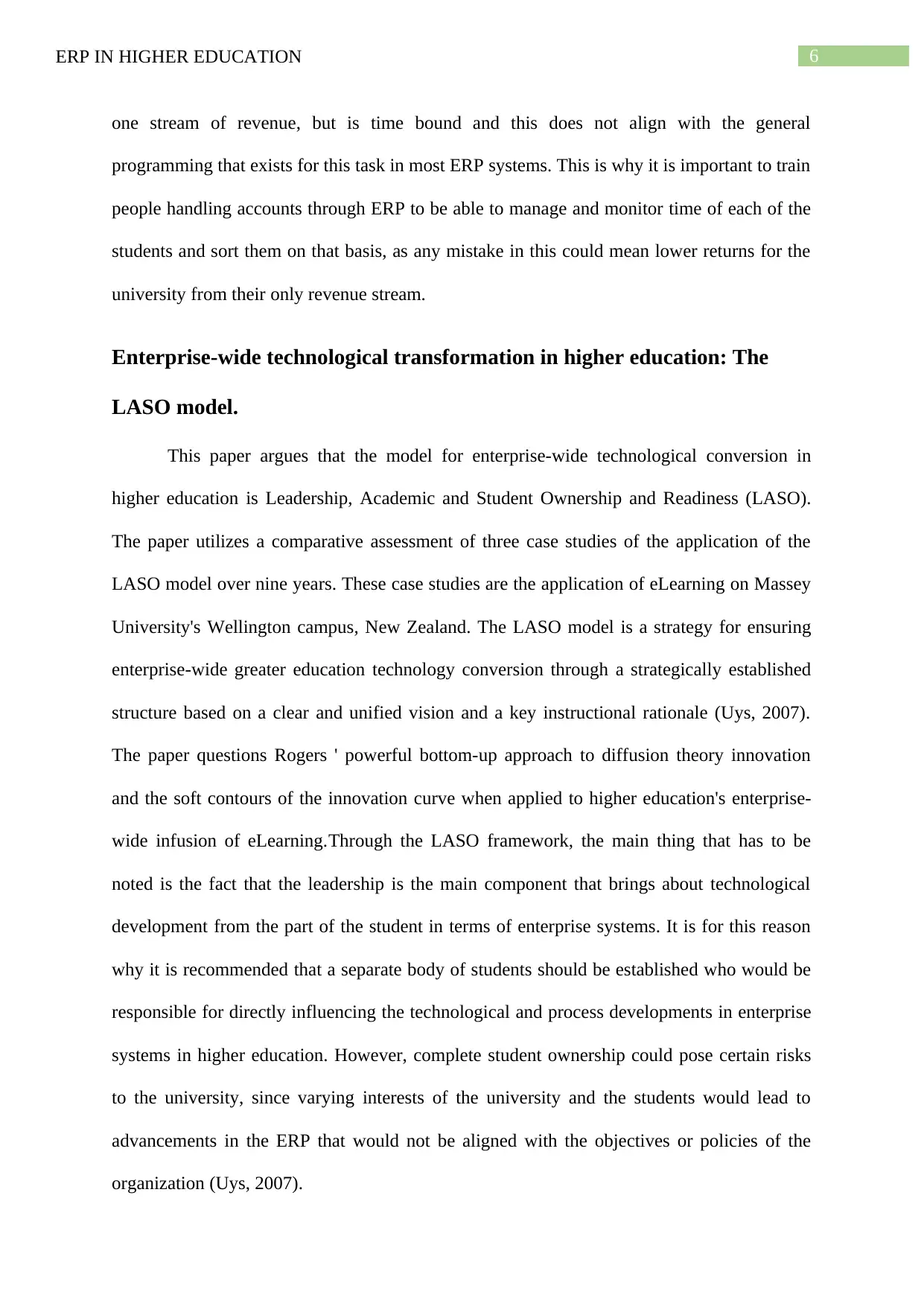
6ERP IN HIGHER EDUCATION
one stream of revenue, but is time bound and this does not align with the general
programming that exists for this task in most ERP systems. This is why it is important to train
people handling accounts through ERP to be able to manage and monitor time of each of the
students and sort them on that basis, as any mistake in this could mean lower returns for the
university from their only revenue stream.
Enterprise-wide technological transformation in higher education: The
LASO model.
This paper argues that the model for enterprise-wide technological conversion in
higher education is Leadership, Academic and Student Ownership and Readiness (LASO).
The paper utilizes a comparative assessment of three case studies of the application of the
LASO model over nine years. These case studies are the application of eLearning on Massey
University's Wellington campus, New Zealand. The LASO model is a strategy for ensuring
enterprise-wide greater education technology conversion through a strategically established
structure based on a clear and unified vision and a key instructional rationale (Uys, 2007).
The paper questions Rogers ' powerful bottom-up approach to diffusion theory innovation
and the soft contours of the innovation curve when applied to higher education's enterprise-
wide infusion of eLearning.Through the LASO framework, the main thing that has to be
noted is the fact that the leadership is the main component that brings about technological
development from the part of the student in terms of enterprise systems. It is for this reason
why it is recommended that a separate body of students should be established who would be
responsible for directly influencing the technological and process developments in enterprise
systems in higher education. However, complete student ownership could pose certain risks
to the university, since varying interests of the university and the students would lead to
advancements in the ERP that would not be aligned with the objectives or policies of the
organization (Uys, 2007).
one stream of revenue, but is time bound and this does not align with the general
programming that exists for this task in most ERP systems. This is why it is important to train
people handling accounts through ERP to be able to manage and monitor time of each of the
students and sort them on that basis, as any mistake in this could mean lower returns for the
university from their only revenue stream.
Enterprise-wide technological transformation in higher education: The
LASO model.
This paper argues that the model for enterprise-wide technological conversion in
higher education is Leadership, Academic and Student Ownership and Readiness (LASO).
The paper utilizes a comparative assessment of three case studies of the application of the
LASO model over nine years. These case studies are the application of eLearning on Massey
University's Wellington campus, New Zealand. The LASO model is a strategy for ensuring
enterprise-wide greater education technology conversion through a strategically established
structure based on a clear and unified vision and a key instructional rationale (Uys, 2007).
The paper questions Rogers ' powerful bottom-up approach to diffusion theory innovation
and the soft contours of the innovation curve when applied to higher education's enterprise-
wide infusion of eLearning.Through the LASO framework, the main thing that has to be
noted is the fact that the leadership is the main component that brings about technological
development from the part of the student in terms of enterprise systems. It is for this reason
why it is recommended that a separate body of students should be established who would be
responsible for directly influencing the technological and process developments in enterprise
systems in higher education. However, complete student ownership could pose certain risks
to the university, since varying interests of the university and the students would lead to
advancements in the ERP that would not be aligned with the objectives or policies of the
organization (Uys, 2007).
Paraphrase This Document
Need a fresh take? Get an instant paraphrase of this document with our AI Paraphraser
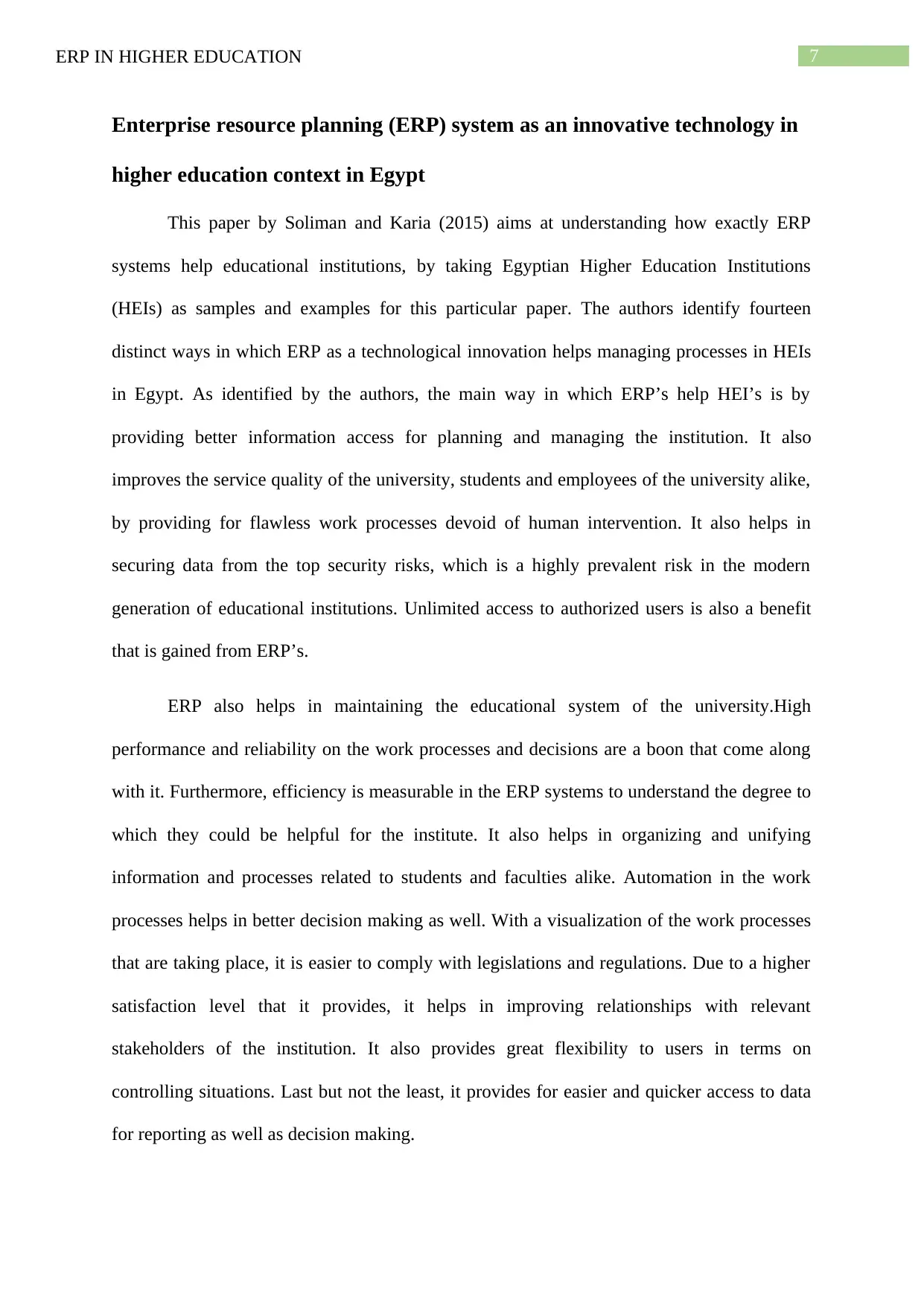
7ERP IN HIGHER EDUCATION
Enterprise resource planning (ERP) system as an innovative technology in
higher education context in Egypt
This paper by Soliman and Karia (2015) aims at understanding how exactly ERP
systems help educational institutions, by taking Egyptian Higher Education Institutions
(HEIs) as samples and examples for this particular paper. The authors identify fourteen
distinct ways in which ERP as a technological innovation helps managing processes in HEIs
in Egypt. As identified by the authors, the main way in which ERP’s help HEI’s is by
providing better information access for planning and managing the institution. It also
improves the service quality of the university, students and employees of the university alike,
by providing for flawless work processes devoid of human intervention. It also helps in
securing data from the top security risks, which is a highly prevalent risk in the modern
generation of educational institutions. Unlimited access to authorized users is also a benefit
that is gained from ERP’s.
ERP also helps in maintaining the educational system of the university.High
performance and reliability on the work processes and decisions are a boon that come along
with it. Furthermore, efficiency is measurable in the ERP systems to understand the degree to
which they could be helpful for the institute. It also helps in organizing and unifying
information and processes related to students and faculties alike. Automation in the work
processes helps in better decision making as well. With a visualization of the work processes
that are taking place, it is easier to comply with legislations and regulations. Due to a higher
satisfaction level that it provides, it helps in improving relationships with relevant
stakeholders of the institution. It also provides great flexibility to users in terms on
controlling situations. Last but not the least, it provides for easier and quicker access to data
for reporting as well as decision making.
Enterprise resource planning (ERP) system as an innovative technology in
higher education context in Egypt
This paper by Soliman and Karia (2015) aims at understanding how exactly ERP
systems help educational institutions, by taking Egyptian Higher Education Institutions
(HEIs) as samples and examples for this particular paper. The authors identify fourteen
distinct ways in which ERP as a technological innovation helps managing processes in HEIs
in Egypt. As identified by the authors, the main way in which ERP’s help HEI’s is by
providing better information access for planning and managing the institution. It also
improves the service quality of the university, students and employees of the university alike,
by providing for flawless work processes devoid of human intervention. It also helps in
securing data from the top security risks, which is a highly prevalent risk in the modern
generation of educational institutions. Unlimited access to authorized users is also a benefit
that is gained from ERP’s.
ERP also helps in maintaining the educational system of the university.High
performance and reliability on the work processes and decisions are a boon that come along
with it. Furthermore, efficiency is measurable in the ERP systems to understand the degree to
which they could be helpful for the institute. It also helps in organizing and unifying
information and processes related to students and faculties alike. Automation in the work
processes helps in better decision making as well. With a visualization of the work processes
that are taking place, it is easier to comply with legislations and regulations. Due to a higher
satisfaction level that it provides, it helps in improving relationships with relevant
stakeholders of the institution. It also provides great flexibility to users in terms on
controlling situations. Last but not the least, it provides for easier and quicker access to data
for reporting as well as decision making.
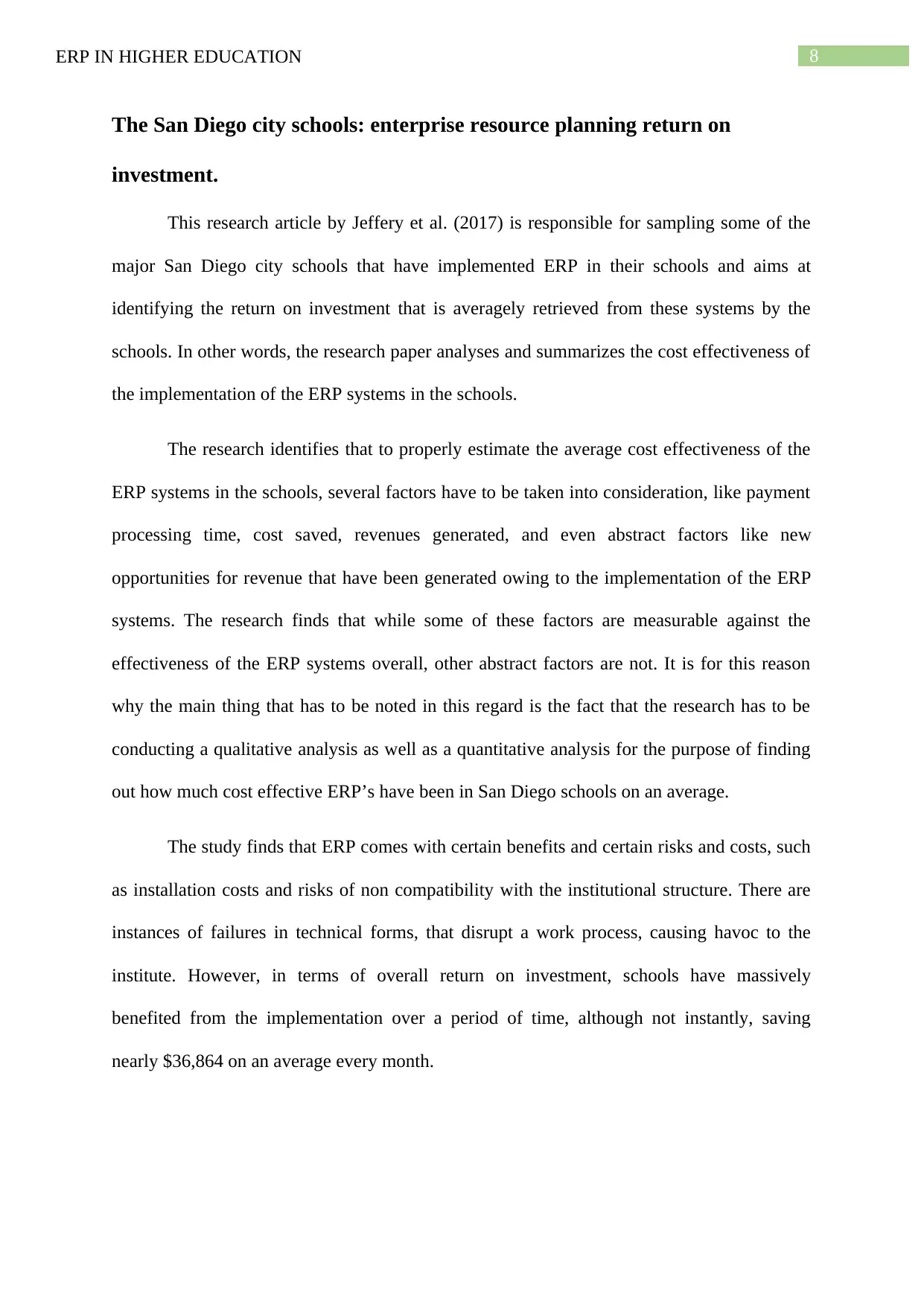
8ERP IN HIGHER EDUCATION
The San Diego city schools: enterprise resource planning return on
investment.
This research article by Jeffery et al. (2017) is responsible for sampling some of the
major San Diego city schools that have implemented ERP in their schools and aims at
identifying the return on investment that is averagely retrieved from these systems by the
schools. In other words, the research paper analyses and summarizes the cost effectiveness of
the implementation of the ERP systems in the schools.
The research identifies that to properly estimate the average cost effectiveness of the
ERP systems in the schools, several factors have to be taken into consideration, like payment
processing time, cost saved, revenues generated, and even abstract factors like new
opportunities for revenue that have been generated owing to the implementation of the ERP
systems. The research finds that while some of these factors are measurable against the
effectiveness of the ERP systems overall, other abstract factors are not. It is for this reason
why the main thing that has to be noted in this regard is the fact that the research has to be
conducting a qualitative analysis as well as a quantitative analysis for the purpose of finding
out how much cost effective ERP’s have been in San Diego schools on an average.
The study finds that ERP comes with certain benefits and certain risks and costs, such
as installation costs and risks of non compatibility with the institutional structure. There are
instances of failures in technical forms, that disrupt a work process, causing havoc to the
institute. However, in terms of overall return on investment, schools have massively
benefited from the implementation over a period of time, although not instantly, saving
nearly $36,864 on an average every month.
The San Diego city schools: enterprise resource planning return on
investment.
This research article by Jeffery et al. (2017) is responsible for sampling some of the
major San Diego city schools that have implemented ERP in their schools and aims at
identifying the return on investment that is averagely retrieved from these systems by the
schools. In other words, the research paper analyses and summarizes the cost effectiveness of
the implementation of the ERP systems in the schools.
The research identifies that to properly estimate the average cost effectiveness of the
ERP systems in the schools, several factors have to be taken into consideration, like payment
processing time, cost saved, revenues generated, and even abstract factors like new
opportunities for revenue that have been generated owing to the implementation of the ERP
systems. The research finds that while some of these factors are measurable against the
effectiveness of the ERP systems overall, other abstract factors are not. It is for this reason
why the main thing that has to be noted in this regard is the fact that the research has to be
conducting a qualitative analysis as well as a quantitative analysis for the purpose of finding
out how much cost effective ERP’s have been in San Diego schools on an average.
The study finds that ERP comes with certain benefits and certain risks and costs, such
as installation costs and risks of non compatibility with the institutional structure. There are
instances of failures in technical forms, that disrupt a work process, causing havoc to the
institute. However, in terms of overall return on investment, schools have massively
benefited from the implementation over a period of time, although not instantly, saving
nearly $36,864 on an average every month.
⊘ This is a preview!⊘
Do you want full access?
Subscribe today to unlock all pages.

Trusted by 1+ million students worldwide
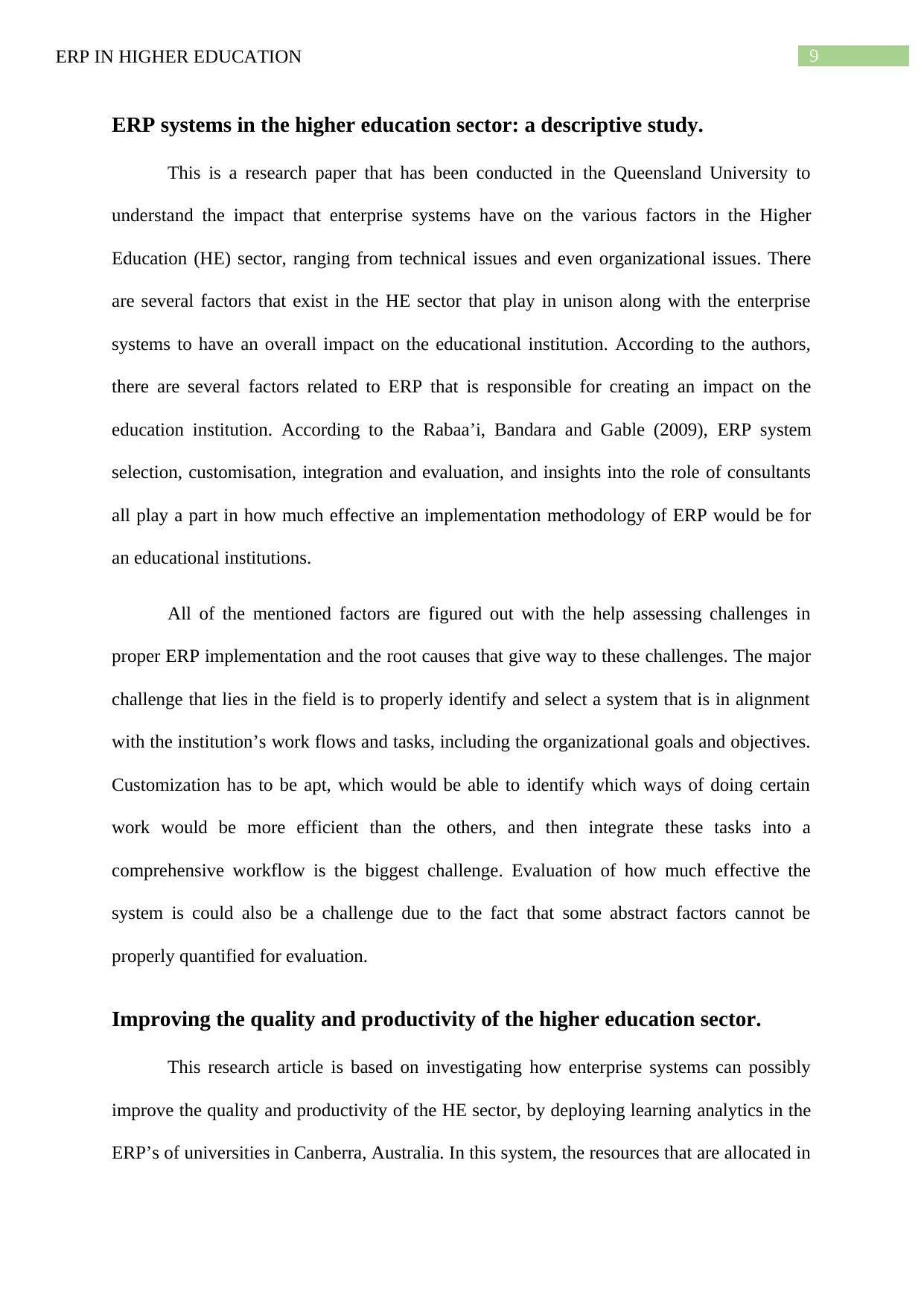
9ERP IN HIGHER EDUCATION
ERP systems in the higher education sector: a descriptive study.
This is a research paper that has been conducted in the Queensland University to
understand the impact that enterprise systems have on the various factors in the Higher
Education (HE) sector, ranging from technical issues and even organizational issues. There
are several factors that exist in the HE sector that play in unison along with the enterprise
systems to have an overall impact on the educational institution. According to the authors,
there are several factors related to ERP that is responsible for creating an impact on the
education institution. According to the Rabaa’i, Bandara and Gable (2009), ERP system
selection, customisation, integration and evaluation, and insights into the role of consultants
all play a part in how much effective an implementation methodology of ERP would be for
an educational institutions.
All of the mentioned factors are figured out with the help assessing challenges in
proper ERP implementation and the root causes that give way to these challenges. The major
challenge that lies in the field is to properly identify and select a system that is in alignment
with the institution’s work flows and tasks, including the organizational goals and objectives.
Customization has to be apt, which would be able to identify which ways of doing certain
work would be more efficient than the others, and then integrate these tasks into a
comprehensive workflow is the biggest challenge. Evaluation of how much effective the
system is could also be a challenge due to the fact that some abstract factors cannot be
properly quantified for evaluation.
Improving the quality and productivity of the higher education sector.
This research article is based on investigating how enterprise systems can possibly
improve the quality and productivity of the HE sector, by deploying learning analytics in the
ERP’s of universities in Canberra, Australia. In this system, the resources that are allocated in
ERP systems in the higher education sector: a descriptive study.
This is a research paper that has been conducted in the Queensland University to
understand the impact that enterprise systems have on the various factors in the Higher
Education (HE) sector, ranging from technical issues and even organizational issues. There
are several factors that exist in the HE sector that play in unison along with the enterprise
systems to have an overall impact on the educational institution. According to the authors,
there are several factors related to ERP that is responsible for creating an impact on the
education institution. According to the Rabaa’i, Bandara and Gable (2009), ERP system
selection, customisation, integration and evaluation, and insights into the role of consultants
all play a part in how much effective an implementation methodology of ERP would be for
an educational institutions.
All of the mentioned factors are figured out with the help assessing challenges in
proper ERP implementation and the root causes that give way to these challenges. The major
challenge that lies in the field is to properly identify and select a system that is in alignment
with the institution’s work flows and tasks, including the organizational goals and objectives.
Customization has to be apt, which would be able to identify which ways of doing certain
work would be more efficient than the others, and then integrate these tasks into a
comprehensive workflow is the biggest challenge. Evaluation of how much effective the
system is could also be a challenge due to the fact that some abstract factors cannot be
properly quantified for evaluation.
Improving the quality and productivity of the higher education sector.
This research article is based on investigating how enterprise systems can possibly
improve the quality and productivity of the HE sector, by deploying learning analytics in the
ERP’s of universities in Canberra, Australia. In this system, the resources that are allocated in
Paraphrase This Document
Need a fresh take? Get an instant paraphrase of this document with our AI Paraphraser
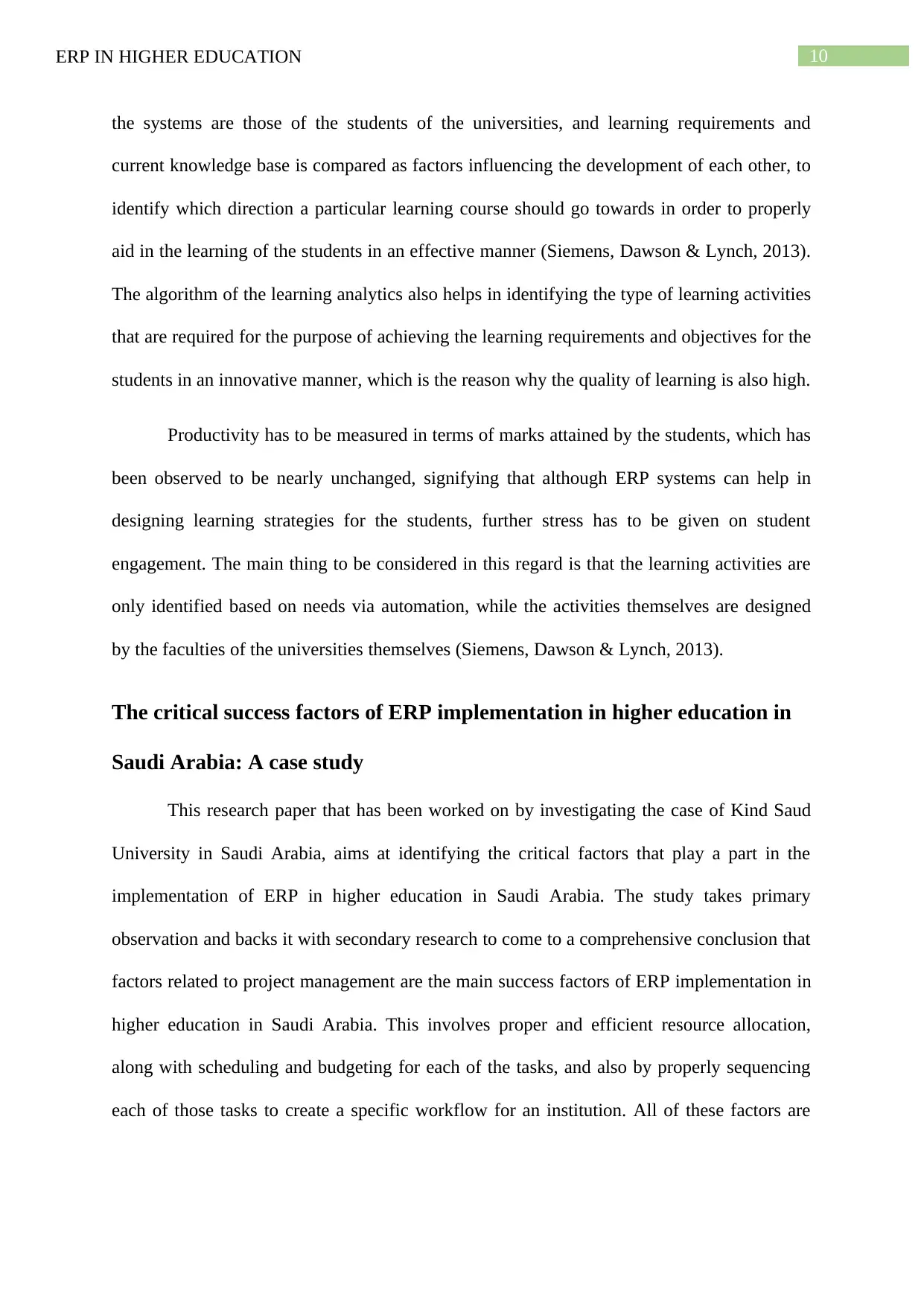
10ERP IN HIGHER EDUCATION
the systems are those of the students of the universities, and learning requirements and
current knowledge base is compared as factors influencing the development of each other, to
identify which direction a particular learning course should go towards in order to properly
aid in the learning of the students in an effective manner (Siemens, Dawson & Lynch, 2013).
The algorithm of the learning analytics also helps in identifying the type of learning activities
that are required for the purpose of achieving the learning requirements and objectives for the
students in an innovative manner, which is the reason why the quality of learning is also high.
Productivity has to be measured in terms of marks attained by the students, which has
been observed to be nearly unchanged, signifying that although ERP systems can help in
designing learning strategies for the students, further stress has to be given on student
engagement. The main thing to be considered in this regard is that the learning activities are
only identified based on needs via automation, while the activities themselves are designed
by the faculties of the universities themselves (Siemens, Dawson & Lynch, 2013).
The critical success factors of ERP implementation in higher education in
Saudi Arabia: A case study
This research paper that has been worked on by investigating the case of Kind Saud
University in Saudi Arabia, aims at identifying the critical factors that play a part in the
implementation of ERP in higher education in Saudi Arabia. The study takes primary
observation and backs it with secondary research to come to a comprehensive conclusion that
factors related to project management are the main success factors of ERP implementation in
higher education in Saudi Arabia. This involves proper and efficient resource allocation,
along with scheduling and budgeting for each of the tasks, and also by properly sequencing
each of those tasks to create a specific workflow for an institution. All of these factors are
the systems are those of the students of the universities, and learning requirements and
current knowledge base is compared as factors influencing the development of each other, to
identify which direction a particular learning course should go towards in order to properly
aid in the learning of the students in an effective manner (Siemens, Dawson & Lynch, 2013).
The algorithm of the learning analytics also helps in identifying the type of learning activities
that are required for the purpose of achieving the learning requirements and objectives for the
students in an innovative manner, which is the reason why the quality of learning is also high.
Productivity has to be measured in terms of marks attained by the students, which has
been observed to be nearly unchanged, signifying that although ERP systems can help in
designing learning strategies for the students, further stress has to be given on student
engagement. The main thing to be considered in this regard is that the learning activities are
only identified based on needs via automation, while the activities themselves are designed
by the faculties of the universities themselves (Siemens, Dawson & Lynch, 2013).
The critical success factors of ERP implementation in higher education in
Saudi Arabia: A case study
This research paper that has been worked on by investigating the case of Kind Saud
University in Saudi Arabia, aims at identifying the critical factors that play a part in the
implementation of ERP in higher education in Saudi Arabia. The study takes primary
observation and backs it with secondary research to come to a comprehensive conclusion that
factors related to project management are the main success factors of ERP implementation in
higher education in Saudi Arabia. This involves proper and efficient resource allocation,
along with scheduling and budgeting for each of the tasks, and also by properly sequencing
each of those tasks to create a specific workflow for an institution. All of these factors are
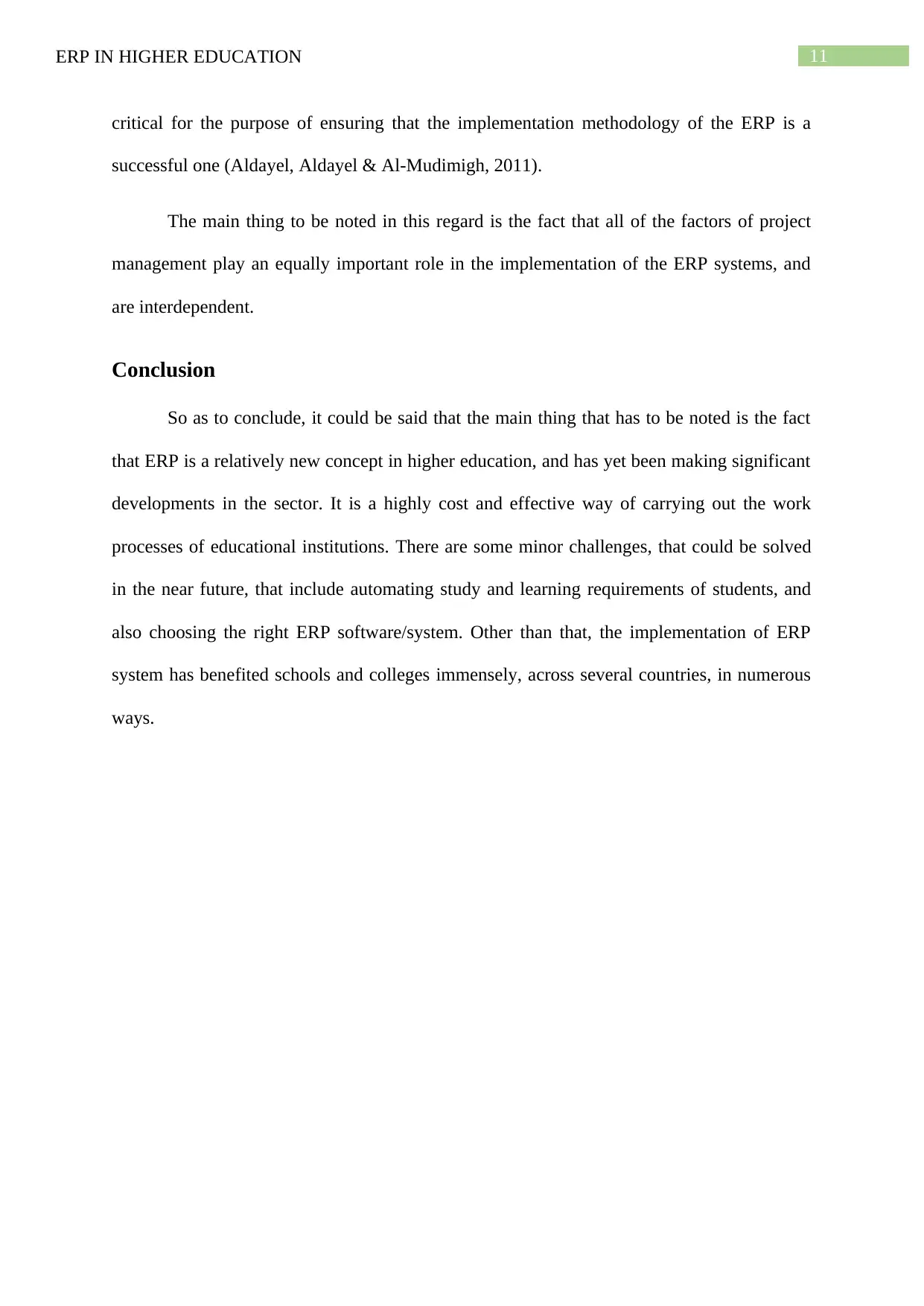
11ERP IN HIGHER EDUCATION
critical for the purpose of ensuring that the implementation methodology of the ERP is a
successful one (Aldayel, Aldayel & Al-Mudimigh, 2011).
The main thing to be noted in this regard is the fact that all of the factors of project
management play an equally important role in the implementation of the ERP systems, and
are interdependent.
Conclusion
So as to conclude, it could be said that the main thing that has to be noted is the fact
that ERP is a relatively new concept in higher education, and has yet been making significant
developments in the sector. It is a highly cost and effective way of carrying out the work
processes of educational institutions. There are some minor challenges, that could be solved
in the near future, that include automating study and learning requirements of students, and
also choosing the right ERP software/system. Other than that, the implementation of ERP
system has benefited schools and colleges immensely, across several countries, in numerous
ways.
critical for the purpose of ensuring that the implementation methodology of the ERP is a
successful one (Aldayel, Aldayel & Al-Mudimigh, 2011).
The main thing to be noted in this regard is the fact that all of the factors of project
management play an equally important role in the implementation of the ERP systems, and
are interdependent.
Conclusion
So as to conclude, it could be said that the main thing that has to be noted is the fact
that ERP is a relatively new concept in higher education, and has yet been making significant
developments in the sector. It is a highly cost and effective way of carrying out the work
processes of educational institutions. There are some minor challenges, that could be solved
in the near future, that include automating study and learning requirements of students, and
also choosing the right ERP software/system. Other than that, the implementation of ERP
system has benefited schools and colleges immensely, across several countries, in numerous
ways.
⊘ This is a preview!⊘
Do you want full access?
Subscribe today to unlock all pages.

Trusted by 1+ million students worldwide
1 out of 14
Related Documents
Your All-in-One AI-Powered Toolkit for Academic Success.
+13062052269
info@desklib.com
Available 24*7 on WhatsApp / Email
![[object Object]](/_next/static/media/star-bottom.7253800d.svg)
Unlock your academic potential
Copyright © 2020–2025 A2Z Services. All Rights Reserved. Developed and managed by ZUCOL.





